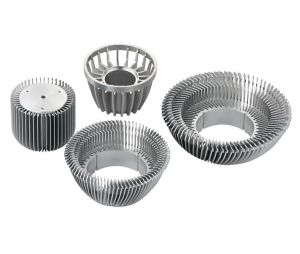

Zhi Gao specializes in the production of LED aluminum heat sinks. As shown in the figure, it is an LED sunflower radiator, which is used in LED spotlights, LED street lights and other lamps.
Aluminum profile has the advantages of light weight, beautiful and durable, high heat dissipation rate, good shapeability, etc., and has been widely used in air conditioners, coolers and radiators. In my country, the use of aluminum profiles for radiators is becoming more and more popular, and aluminum extrusion is the main form. This is because the extrusion-formed blanks have a good size consistency, a short production cycle and a relatively low cost.
LED heat dissipation methods include radiation, conduction and convection.
Radiation means that the body emits infrared rays to dissipate heat. When the skin temperature is higher than the ambient temperature, the body's heat is radiated away. The amount of radiation heat is related to factors such as skin temperature, ambient temperature and effective radiation area of the body. In general, radiant heat dissipation accounts for 40% of the total heat dissipation. Of course, if the ambient temperature is higher than the skin temperature, the body will absorb radiant heat. Steel workers work in front of the furnace, and farmers will also encounter this situation when working in the fields under the sun in the hot summer.
Conduction is the way the body emits heat by transferring molecular kinetic energy. When the human body is in direct contact with objects that are cooler than the skin (such as clothes, beds, chairs, etc.), heat is transferred from the body to these objects. Clinically, using ice caps and ice packs to cool patients with high fever uses this principle.
Convection is the flow of air, which uses air as a medium for heat dissipation.
Aluminum radiator is the most common radiator in the early days. Its manufacturing process is simple and low in cost. So far, aluminum radiator still occupies a considerable part of the market.
